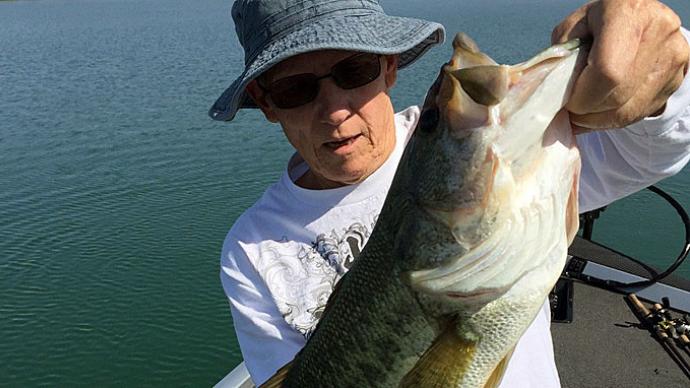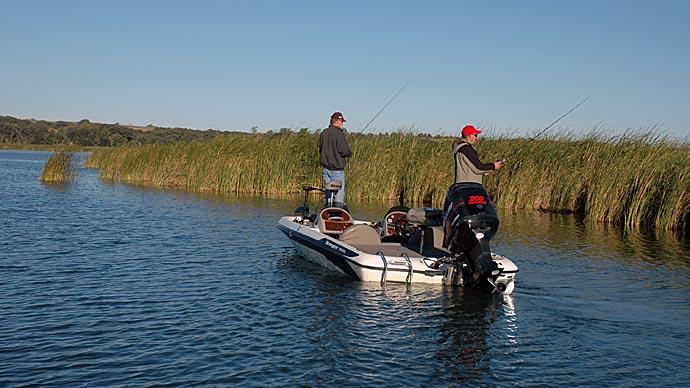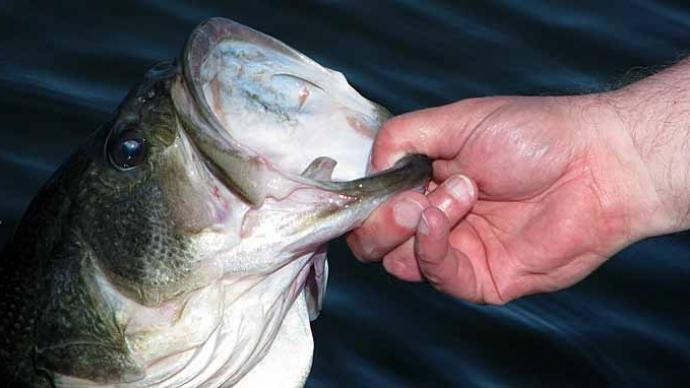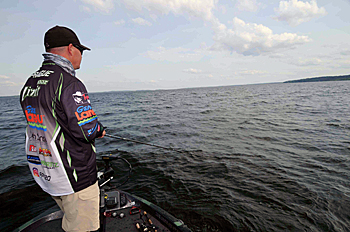
Whether he’s practicing for or competing in a tournament, Jeff Sprague relies on the “old ball and chain” for finding fish and loading up his livewell in a hurry.
The ball and chain is the Carolina rig consisting of a sinker, bead, and swivel combined with a leader line, hook, and a soft plastic bait. “A Carolina rig is a great way to cover water deep and shallow,” Sprague says. “It maintains bottom contact well, and you can fish it faster. You can also change to various baits that follow it so it is a little more versatile than a jig (or Texas rig).”
The bead-and-weight combo constantly clicking when it bumps the bottom makes the rig ideal for fishing in clear or stained water. Sprague believes the clicking noise imitates the sound of the flapping tail of a fleeing crayfish.
Sprague opts for the “old school” egg-shaped weight for his Carolina rig and prefers using a heavy weight. “Some guys like to use a light weight, but to me, that defeats its purpose,” he says. “I want that bait and that line and everything to maintain bottom contact so that I can feel what is down there. I want to know if I am on rock or wood or if the bottom is mushy. I want to know what’s there so that heavier weight is a key for me.” The lightest weight he uses is a 3/4-ounce version, and he upgrades at times to 1 or 1 1/4 ounce.
The Major League Tour pro slides his sinker on a main line of 17-pound fluorocarbon and follows up with a glass bead and a number 6 barrel swivel. He ties a leader line of 14-pound monofilament to the swivel and adds a 3/0 or 4/0 Gamakatsu worm hook to the other end of the leader. The tournament competitor prefers a light wire hook to help the lure remain off the bottom and prevent hanging up in any bottom cover.
Sprague’s favorite lures for Carolina rigging are the Zoom Brush Hog and the Gene Larew TattleTail worm. He usually starts with a 4-inch Brush Hog Baby, and if he keeps getting bites on that lure, he eventually switches to the 6–inch Brush Hog to tempt bigger bass. The Tattletail is his choice when the fishing gets tough. Green pumpkin is the best all-around color for his Carolina rig baits, but Sprague also likes red shad or red bug for summertime rigging.
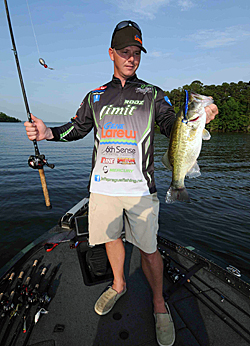
The length of Sprague’s leader line varies depending on the situation. “The leader length is the key to a Carolina rig,” he says. “That is a huge deal. I have seen guys throw 8-foot leaders and take a running start to make a cast, and I have seen guys throw a 12-inch leader.”
A longer leader is necessary for fishing in the grass to keep the bait floating above the vegetation. The leader length depends on the height of the grass, but Sprague never uses a leader longer than 36 inches. “That is a long leader for me,” he says. “I fish a Carolina rig sometimes (with a leader) as short as 18 inches.”
If he is fishing shallow with a rig, Sprague shortens his leader because he believes bass might key on the weight instead of the lure if the leader is too long. Sprague ties on a longer leader when fishing deeper water, which allows the bait to rise off the bottom and fall back down as he retrieves the rig. “A guy just has to experiment with length and check how high the fish are suspended off the bottom,” Sprague says.
Sprague starts his rig presentation with a long cast and lets the weight fall to the bottom. Then he steadily pulls the rig with his rod kept at a low angle, so the weight stays in constant contact with the bottom. He prefers pulling the rig horizontally rather than lifting it and letting it fall along the bottom. Sprague will lift his rod tip to pop it over the obstruction if he is fishing around brush or stumps. “When I give it that pop, it makes that bait pop up off the bottom, and if there is a bass following the bait, it will be an instant reaction bite,” he says.
The Texas pro relies on a 7 1/2-foot heavy action rod with a fast tip which gives him a better feel for detecting strikes as he bumps the rig along the bottom. “A Carolina rig bite is not like a lot of any other bites that you feel,” Sprague says. “Most of the time, it feels like you have a dirty sock on the end of your bait, and it just gets heavy.”
Most bites on a Carolina rig come long distances from the boat, so Sprague also needs a rod with a lot of backbone for setting the hook. He also prefers a high-speed baitcast reel (7.1:1 gear ratio) that helps him quickly reel in any slack line after a fish bites.
According to Sprague, an overhead jerk of the rod is the biggest mistake novices make when setting the hook while Carolina rigging. He warns the force of an overhead hookset jerks the weight off the bottom instead of driving the hook into the fish. So Sprague suggests setting the hook with a low sweeping action that keeps the weight down and exerts full force down the line to the hook.
Sprague’s favorite time for Carolina rigging is the post-spawn in the spring and throughout the summer. He likes dragging it over long clay points where bass move up and down on the structure. The Texas angler has caught bass on the rig as shallow as 18 inches and as deep as 30 feet.
BassResource may receive a portion of revenues if you make a purchase using a link above.


